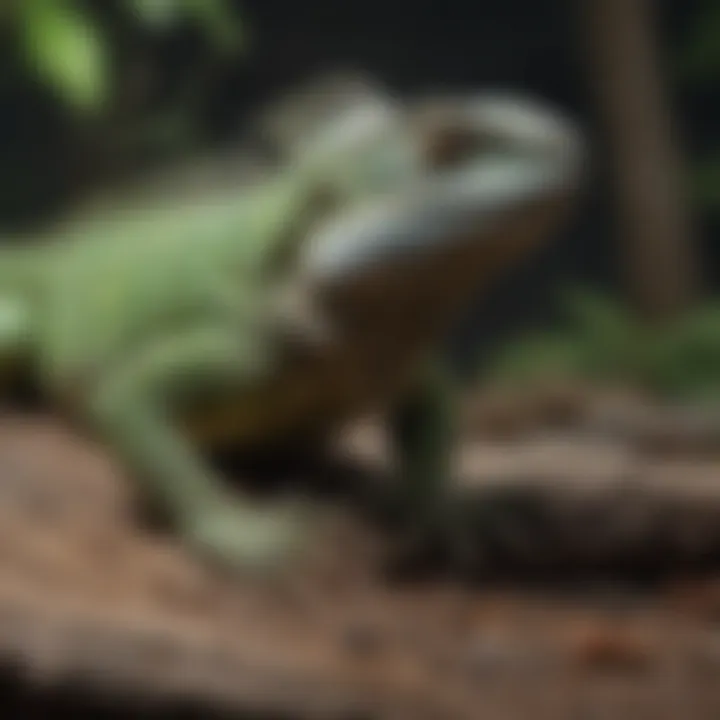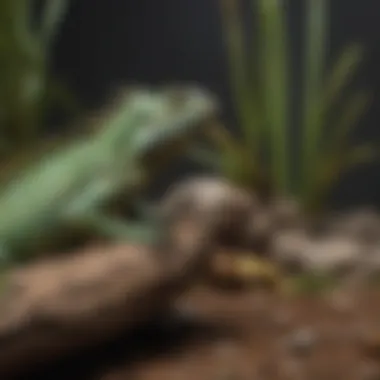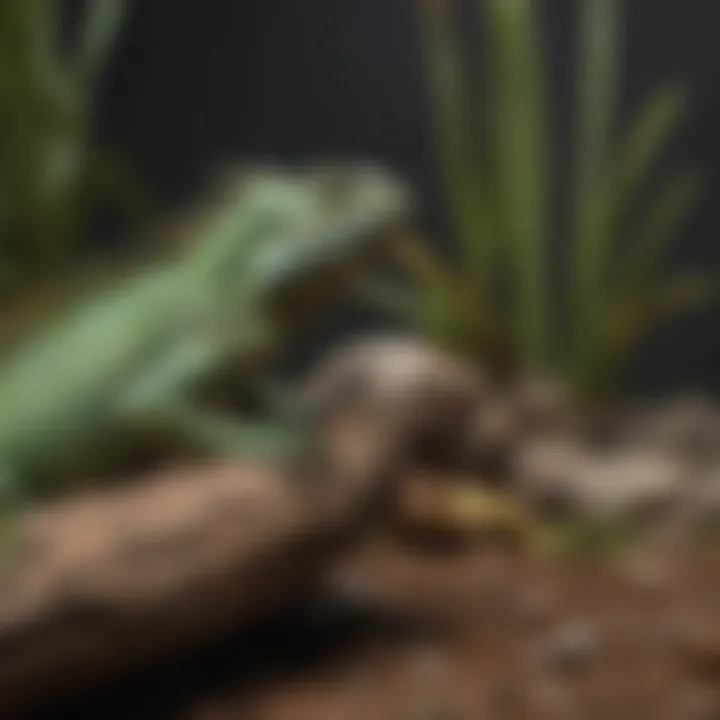Choosing the Right Substrate for Iguanas


Intro
Selecting the right substrate is a fundamental aspect of iguana care. It influences not just the aesthetic appeal of the habitat but also the health and wellbeing of your iguana. Substrate serves various functions including providing comfort, aiding in temperature regulation, and facilitating natural behaviors.
Understanding the types of substrates available is essential for creating a suitable environment. Each type has its own set of advantages and disadvantages, making informed choices critical. This guide aims to present comprehensive insights into substrates, including their benefits, potential hazards, and maintenance requirements.
As you navigate through this guide, you will obtain knowledge on a variety of substrates ranging from natural to synthetic options. Additionally, our discussion will cover essential care practices that are necessary to maintain an optimal habitat for your iguana. By the end, you should feel empowered to make a well-informed decision that best supports your pet's needs while also enhancing your overall experience as an iguana owner.
Care Tips
Providing the correct substrate is not an isolated task; it integrates into daily routines and overall habitat maintenance. Here’s an exploration into essential care routines, cage setup, cleaning practices, and necessary adjustments based on seasons.
Daily Care Routines
Maintaining the substrate is a daily obligation. Observing your iguana’s behavior and interactions with the substrate can signal if adjustments are necessary. Each day, ensure to spot clean any waste or shedding. This simple act can prevent odors and promote a healthier environment.
Cage Setup and Maintenance
Your iguana's habitat setup should start with selecting an appropriate substrate. Options include soil, coconut coir, and paper towels. Choose a substrate that allows for burrowing and hides, which can mimic natural behavior. After settling on a substrate, monitor for its longevity and replace it when it shows signs of wear or contamination.
Hygiene and Cleaning Practices
It’s crucial to establish a cleaning regimen to manage your iguana's living conditions. Regularly changing the substrate, at least once every month, helps maintain hygiene. If using soil or coconut coir, make sure to sift through it to remove waste and uneaten food regularly.
Seasonal Care Adjustments
Seasonal changes may require adjustments in your substrate care. For instance, during winter, the substrate should offer better insulation. In contrast, during summer months, ensuring adequate drainage to prevent mold is equally important. Be attentive to your iguana's behavior across seasons and adjust your care practices accordingly.
Remember: Proper substrate maintenance is not just about cleanliness; it directly impacts your iguana’s health and comfort.
Selecting the right substrate can be a dynamic process, requiring attention to details and an understanding of your iguana's specific needs and preferences. By establishing solid care practices, you enhance the overall quality of life for your pet while ensuring a manageable upkeep for yourself.
Understanding the Role of Substrate in Iguana Care
Substrate is more than just the material that covers the bottom of an iguana's habitat. It plays a critical role in their overall care and wellbeing. The substrate choice affects various aspects of the iguana's environment, such as humidity levels, comfort, and even health. Understanding the significance of substrate can guide iguana owners in creating a habitat that mimics the natural conditions these reptiles thrive in.
Mismatched substrate can lead to discomfort and illness. Thus, knowing what each type offers and its potential risks is vital. For instance, some substrates can retain moisture better, while others allow for more airflow. The right substrate can enhance the iguana's quality of life.
A well-chosen substrate can contribute to mental stimulation as iguanas love to dig and explore. Providing a choice that satisfies these behaviors can prevent stress-related issues in captive iguanas. It’s essential to evaluate various substrates based on their properties, and how they fit the specific needs of your iguana.
Defining Substrate in Reptile Care
In terms of reptile care, substrate refers to the material laid down in a terrarium or enclosure where the reptile lives. It serves multiple purposes, including providing a naturalistic environment, aiding in temperature regulation, and contributing to comfort and security.
Traditional substrates may include soil, sand, or commercial materials designed specifically for reptiles. Each type has its unique characteristics and benefits. For iguanas, the choice of substrate influences not just their physical health but also their psychological well-being. The definition of substrate thus extends beyond just physical material to encompass an integral part of the iguana’s habitat.
Why Substrate Matters for Iguanas
Choosing the right substrate is fundamental for several reasons. First, iguanas are naturally found in humid environments. A substrate that retains moisture can help create necessary humidity levels within the enclosure, contributing to the iguana's hydration and skin health. Excessively dry substrates can lead to shedding problems and skin issues.
Furthermore, iguanas are known for their digging behavior. A suitable substrate should allow for some digging to satisfy their instincts. Not only does this behavior help with exercise, but it also provides mental stimulation which enhances their overall quality of life.
Additionally, some substrates can impact temperatures in the enclosure. Certain materials can trap heat better and provide warmer spots for basking. Getting the temperature right is crucial for iguanas since they’re ectothermic and depend on external heat sources to regulate their body temperature.
"The choice of substrate is vital for the psychological and physical welfare of your iguana."
Overall, integrating the understanding of substrate into iguana care is essential. A well-chosen substrate can support moisture levels, encourage natural behaviors, and contribute to a stable, healthy environment. It is a fundamental piece that every iguana owner must consider for optimal care.
Types of Iguana Substrates
Understanding types of iguana substrates is vital in providing a proper habitat for your pet. Substrate refers to the material you place at the bottom of the enclosure, which can affect your iguana’s health, behavior, and overall well-being. The right substrate helps maintain hydration, provides comfort, and influences the iguana's natural behaviors. Choosing the right substrate types will impact both the aesthetic and functional aspects of the habitat. It allows iguanas to express their digging, basking, and burrowing instincts. Below, we'll explore both natural and synthetic substrate options.


Natural Substrates
Natural substrates mimic the iguana's environment in the wild. They can offer a more naturalistic view, helping to reduce stress on iguanas.
Topsoil
Topsoil is an effective substrate choice for iguanas. Its key characteristic lies in its organic composition and ability to retain moisture. This is beneficial because iguanas thrive in humid conditions. A layered topsoil setup also allows iguanas to dig, which is important for their mental stimulation. One unique feature of topsoil is its potential to support live plants, promoting a natural habitat. However, there are disadvantages too. Unmanaged topsoil can become a breeding ground for bacteria if not maintained properly, leading to health risks.
Sandy soils
Sandy soils are another option for iguana substrates. Their key characteristic is excellent drainage, reducing the risk of mold and bacterial growth. This type represents good airflow and can be easier to clean. Furthermore, iguanas enjoy burrowing in sandy substrates, aligning with their natural behaviors. However, the unique feature of sandy soils is the potential for impaction if ingested. Iguanas may accidentally consume sand while eating, which can lead to digestive issues. Therefore, monitor your iguana closely when using this substrate.
Forest floor mixes
Forest floor mixes typically consist of a blend of organic materials like mulch and natural soil. The key characteristic of forest floor mixes is their ability to retain humidity while allowing for healthy airflow. This combination can provide a comfortable environment for iguanas. A unique advantage of using forest floor mixes includes their potential for aesthetic appeal. They create a more visually stimulating environment for the iguana. However, regular maintenance is required. Accumulation of waste can lead to odor and hygiene issues if not addressed promptly.
Synthetic Substrates
Synthetic substrates have become popular among iguana keepers due to their convenience and ease of use. They provide unique advantages compared to natural options.
Coconut fiber
Coconut fiber is a widely used synthetic substrate. Its key characteristic is its ability to hold moisture well, which is vital for iguana health. This substrate is also biodegradable, making it an environmentally-friendly option. One significant advantage is the soft texture, which could prevent injuries to your iguana's feet. However, caution is necessary. While coconut fiber is generally safe, ingestion can cause blockages if large amounts are eaten. Therefore, monitoring your iguana's behavior is essential when using coconut fiber.
Reptile carpet
Reptile carpets are designed specifically for reptile enclosures. The key characteristic of a reptile carpet is its ease of cleaning, making maintenance less of a chore. This substrate offers a consistent surface, reducing the chances of bacteria flourishing in the habitat. Furthermore, they are made from safe, non-toxic materials. However, one of the unique features is that they do not provide the same naturalistic look as organic substrates. Additionally, the lack of texture can be limiting for iguanas that enjoy digging or burrowing.
Astroturf
Astroturf is synthetic grass that offers certain benefits as a substrate. Its key characteristic involves being easy to clean, similar to reptile carpet. It can provide a soft surface that is comfortable for iguanas. A unique aspect of Astroturf is its ability to mimic natural grass environments. However, it does not retain humidity, potentially leading to dry conditions in the enclosure. This could pose a challenge in maintaining the right humidity level for your iguana's health. Monitor your iguana's responsiveness and adapt the habitat accordingly.
In summary, when selecting substrates, consider the iguana's natural behaviors and the habitat's overall care. Each substrate type comes with its own set of advantages and disadvantages. Assessing your own ability to maintain these substrates will be crucial in making the right choice.
Evaluating Substrate Options
Evaluating substrate options is a critical aspect of iguana care. Substrate serves as the foundational material in your iguana's habitat, impacting health, behavior, and overall wellbeing. Choosing the right substrate requires careful consideration of various factors, including benefits and potential drawbacks.
Benefits of Different Substrates
Humidity retention
Humidity retention is a vital feature when selecting a substrate for iguanas. These reptiles thrive in moist environments, which mimic their natural habitat. A substrate that retains humidity helps maintain the necessary moisture levels in the terrarium. This is particularly crucial for iguanas as it supports proper skin health and prevents dehydration. Substrates like coconut fiber and forest floor mixes are known for their excellent humidity-holding capacity. The unique advantage of these substrates is that they can also help facilitate a more comfortable temperature range, enhancing the habitat's overall climate.
Temperature control
Temperature control is another important consideration in substrate evaluation. Iguanas require specific temperature gradients for basking and cooling. Certain substrates can assist with maintaining these temperature zones within the habitat. For instance, sandy soils tend to promote better heat retention, allowing iguanas to regulate their body temperature effectively. The downside, however, is that they might dry out quicker than other types. Balancing the choice of substrate with heating elements in the enclosure is crucial to ensure a suitable warmth without risking fluctuations that might negatively affect your iguana.
Dirt digging behavior
Iguanas are natural diggers and will often engage in behaviors such as burrowing when provided with a suitable substrate. This digging instinct is not just an entertaining activity; it is essential for their physical and mental health. A substrate that promotes dirt digging can enrich their environment. Soil-based substrates allow iguanas to dig, exploring their enclosure and establishing territories. However, excessive digging in improper substrates can lead to issues such as impaction if they ingest small particles that could block their digestive system.
Drawbacks to Consider
Impaction risks
One significant drawback of certain substrates is the risk of impaction. Iguanas may accidentally ingest substrate material while eating or digging, leading to serious digestive blockages. This risk is particularly high with fine substrates like sand. Additionally, ingesting chemical-laden substrates can introduce toxic elements to their system. Careful monitoring of your iguana's behavior and choosing substrate types that minimize this risk is essential.
Maintenance challenges
Every substrate type comes with its own set of maintenance challenges. For example, natural substrates like topsoil may require frequent replacement to prevent mold growth and odors. Synthetic options, while easier to clean, can often retain heat too effectively, leading to overheating issues. Regular cleaning is necessary to ensure a healthy environment, and maintaining a substrate can be a time-consuming task depending on its nature.
Cost factors


Cost factors can affect decisions regarding substrate options. Natural substrates generally require more frequent replacement, leading to ongoing costs that can accumulate. Synthetic options may present a higher upfront cost but can be more economical long-term if they last longer. Balancing budget with the quality and suitability of the substrate is an important part of evaluating your options.
When choosing the substrate, always weigh its benefits against potential drawbacks to create the best environment for your iguana's health.
Environmental Factors Influencing Substrate Choice
Selecting the right substrate for your iguana is not purely about personal preferences or aesthetic choices. Environmental factors play a significant role in determining which substrate will provide the best living conditions for your pet. Understanding the influence of climate, humidity, and the design of the habitat is crucial for maintaining an optimal environment for your iguana's health and well-being.
Climate and Humidity Considerations
Iguanas are highly sensitive to their surroundings, especially climate and humidity. In regions with higher humidity, moisture-retaining substrates like coconut fiber can be beneficial. The substrate should help maintain a stable level of humidity in the habitat while also allowing for proper drainage. On the other hand, in drier climates, it is vital to choose substrates that do not exacerbate dryness. You might want to consider natural substrates that allow moisture retention but are not overly saturated.
Iguanas benefit from warm and humid environments, as these conditions mimic their natural habitats. Regular monitoring of humidity levels is essential. Ideally, the humidity should be kept between 50-70% for iguanas. Using hygrometers will help in observing these values directly.
Some substrates, like sandy soils, can quickly dry out, requiring frequent misting to ensure the iguana stays hydrated. Conversely, overly moist environments can lead to respiratory issues and fungal infections. Striking a balance between ideal humidity and substrate type is crucial for the iguana's vitality.
Space and Habitat Design
The design of the habitat and the available space also influence substrate choice. A larger enclosure might allow for a variety of substrates to be used. Natural substrates tend to be more forgiving in larger areas where iguanas can roam, dig, and exhibit natural behaviors. However, in smaller enclosures, synthetic options may be easier to maintain. They often come with less risk of impaction, especially in young iguanas.
When designing the habitat, keep the iguana's behavioral needs in mind. Iguanas enjoy digging and burrowing, so a substrate that encourages these activities could be beneficial. However, a space with limited options might necessitate synthetic materials that do not have the same texture.
Making thoughtful choices based on both space and habitat design will help create a safe and comfortable environment for your iguana. Ultimately, considering these environmental factors thoughtfully will help you choose a substrate that not only suits your aesthetic desires but also caters to the specific needs of your iguana.
Maintaining Ideal Substrate Conditions
Maintaining ideal substrate conditions is critical for the overall health and well-being of your iguana. The substrate is not just a decorative aspect of the habitat. It serves multiple functions, including aiding in temperature control, moisture retention, and providing a physical medium for natural behaviors. A well-maintained substrate ensures that both the iguana’s needs and the environmental conditions are met effectively.
Furthermore, the substrate can influence the overall hygiene of the habitat. Accumulated waste, mold, or stagnant moisture can lead to serious health risks. The importance of vigilance in substrate care cannot be overstated; it can be the line between a thriving pet and one who suffers from preventable illnesses.
Regular Cleaning Procedures
Regular cleaning is a fundamental aspect of maintaining substrate conditions. The frequency of cleaning can depend on the size of the iguana, the type of substrate, and the general activity level of the pet. It's recommended to perform spot cleaning daily and a more thorough cleaning weekly. During spot cleaning, remove visible waste, uneaten food, and any dead plant material. This practice helps to keep bacterial growth at bay.
In addition to spot cleaning, a deep clean is necessary. This can involve replacing a portion of the substrate, rinsing or disinfecting solid elements, and ensuring that any water sources are clean. Proper cleaning also helps in monitoring substrate conditions—changes in smell or texture can indicate larger issues that need to be addressed.
"Keeping the habitat clean is not only about aesthetics but also about ensuring a healthy living environment for your iguana."
Cleaning Tips:
- Use a gentle, non-toxic cleaner suitable for reptile habitats.
- Avoid strong chemical cleaners as these can be harmful.
- Inspect the substrate for mold or decomposition during cleaning.
Monitoring Humidity Levels
High humidity is beneficial to iguanas, mimicking their natural habitat, but it must be carefully monitored. Many substrate types offer varying moisture retention capabilities. For example, coconut fiber may retain moisture well, while sand might dry out rapidly. Therefore, it is essential to understand how your substrate behaves under different conditions.
Using a hygrometer can aid in tracking humidity levels. Ideally, humidity levels for iguanas should be kept between 60% and 80%. If levels drop too low, it can lead to dehydration, shedding issues, and respiratory problems. Conversely, too much humidity can promote mold growth and lead to respiratory difficulties.
Monitoring Tips:
- Regularly check humidity levels, especially in fluctuating environments.
- Adjust substrate thickness or type based on seasonal changes or heating needs.
- Ensure adequate ventilation in the tank to promote a healthy balance.
Safety Considerations with Substrates
Choosing the right substrate for your iguana involves more than just aesthetics or personal preference. Safety considerations play a pivotal role in ensuring the health and well-being of your iguana. Substrates can significantly impact your pet's environment, leading to potential hazards if not selected carefully. Issues such as toxicity, impaction, and other health risks must be taken into account to maintain a suitable habitat. By understanding these factors, iguana keepers can create a safer environment that supports their reptiles' needs.
Identifying Hazardous Materials
The first step in ensuring a safe substrate for your iguana is to identify materials that may pose risks. Some substrates can contain harmful chemicals or materials that could be toxic to reptiles. For example:
- Cedar and pine shavings: Often used due to their aroma, these woods can release phenols which are harmful to iguanas.
- Unprocessed soil: It may contain pesticides and fertilizers. It's crucial to avoid any substrate that has unknown chemical additives.
- Certain decorative stones: Some brands may claim to be safe yet have sharp edges that can injure iguanas.
- Synthetic fibers: These can cause digestive issues if ingested. Inspect any carpet or fabric for fraying.


When selecting a substrate, research product safety information or opt for vetted brands. Avoid harmful materials to create a healthier space for your iguana.
Impaction and Other Health Risks
One of the most serious risks associated with iguana substrates is impaction, which occurs when a reptile ingests substrate materials. This can lead to severe intestinal blockages, requiring medical intervention. Factors that contribute to impaction include:
- Particle size: Fine substrates like sand can be ingested easily, leading to blockages. Coarser textures, though less likely to be ingested, may still pose risks if a substrate is mixed with food.
- Digestive behavior: Iguanas, naturally curious animals, may explore their habitat by tasting different materials. Educating yourself about their habits can help mitigate this risk.
- Litter boxes: If providing a litter area, use digestible substances like coconut fiber. Avoid traditional cat litter, as it could cause health problems if ingested.
Maintaining awareness of the dangers associated with substrates will enhance your iguana's care. Regular inspections and cleaning of the substrate not only keep it safe but also encourage a healthy living environment for your pet.
Case Studies on Iguana Substrate Choices
The topic of case studies on iguana substrate choices serves a vital role within this guide. These studies illuminate real-world experiences of iguana owners, guiding potential decisions about substrate selection. By examining both successful and adverse cases, readers can gain insight into the practical implications of substrate choices. Successful case studies showcase what materials work well and promote the health of iguanas, while adverse effects reveal potential dangers and missteps that might exist. Each case provides critical learning opportunities for iguana keepers and enhances understanding of how different substrates physically affect iguanas in their environments.
Successful Natural Substrate Experiences
Natural substrates can yield successful outcomes when chosen wisely. For example, some iguana owners have reported using a topsoil and coconut coir mix. In such cases, iguanas thrived with improved digging and burrowing behavior, replicating their natural habitat. Enthusiasts praised this mix for moisture retention, helping maintain a suitable humidity level. This case also indicates that iguanas showed fewer signs of stress and exhibited increased activity. These factors point to an appropriate balance between the natural environment and the safety of the iguana's living quarters.
In another instance, an owner utilized a forest floor mix, which consisted of shredded mulch and organic matter. This substrate choice created a comfortable and stimulating environment. The iguana in this study showed an increase in exploratory behavior, reflecting a significant benefit of enriched substrates. Experiences such as these support the argument for using natural materials that closely resemble an iguana's indigenous environment. As a result, they often lead to healthier, more engaged pets.
Adverse Effects of Improper Substrate
Conversely, the repercussions of misguidance in substrate choice can be severe. Several cases highlight the adverse effects experienced by iguana owners who selected improper substrates. For instance, some individuals opted for sand-based substrates in hopes of facilitating natural behaviors like digging. Unfortunately, this led to impaction risks, a serious condition where iguanas ingest substrate particles. Many reported that this dangerous situation often resulted in costly veterinarian visits or, in some cases, the loss of the pet.
Another troubling case involved the use of cedar shavings, which some owners believed were ideal due to their aromatic nature. However, cedar contains phenols that can lead to respiratory issues in iguanas. Owners that utilized this substrate faced sudden declines in the health of their pets. Such instances are reminders of the necessity for careful substrate selection.
A well-informed substrate choice can significantly impact the health and wellbeing of your iguana, while poor choices can have dire consequences for their quality of life.
In summary, case studies serve as crucial instructional material. Understanding both the successes and failures allows iguana keepers to make informed decisions that can directly affect the wellbeing of their animals. By evaluating various experiences, one can better grasp which substrates might foster a thriving iguana habitat.
Comparative Analysis of Popular Substrate Brands
Choosing the right substrate for your iguana is not just about picking something visually appealing. It involves understanding the specific needs of your iguana and how different substrates can meet those needs. This section analyzes popular substrate brands, focusing on their characteristics, pros and cons, and how they contribute to a healthy environment for your iguana.
Reviewing Top Natural Substrate Products
Natural substrate options are often more aligned with the iguana's natural habitat. Two popular brands in this category are Zoo Med Eco Earth and Forest Floor.
Zoo Med Eco Earth is made from compressed coconut fiber. It is biodegradable and retains moisture well, which helps maintain humidity levels. The texture allows iguanas to dig, providing a more stimulating environment. However, it can become compacted over time, making cleaning a challenge.
Forest Floor, on the other hand, contains shredded cypress mulch. This product is excellent for humidity retention and allows for natural foraging behavior. It is soft on iguana skin, minimizing injury risk. One downside is that it may break down faster than other natural substrates, leading to more frequent replacements.
Evaluating Synthetic Substrate Brands
Synthetic substrates offer their own sets of advantages and disadvantages. Common brands include Exo Terra Reptile Carpet and Zilla's Reptile Terrarium Liner.
Exo Terra Reptile Carpet is an attractive option. It is designed specifically for reptiles, and it can be cut to fit any terrarium size. The carpet is easy to clean, and it ensures that iguanas do not ingest anything harmful. However, it tends to retain odors, requiring regular washing to maintain freshness.
Zilla's Reptile Terrarium Liner provides a different approach. It mimics natural earth surfaces but is made of synthetic materials. This option absorbs moisture effectively and helps control humidity, which is essential for iguanas. However, the downside is that it can fray over time, creating a potential hazard for your pet if ingested.
"Choosing the right substrate impacts your iguana's health and comfort. Understanding the strengths and weaknesses of each brand can guide better decisions."
In summary, the comparative analysis of popular substrate brands offers valuable insight for iguana owners. By considering the material characteristics and how they align with the iguana's needs, one can create a conducive habitat. Proper evaluation leads to informed choices, resulting in a healthier and more enriching living environment for pet iguanas.
Summary and Final Recommendations
Choosing the right substrate for your iguana is a significant aspect of their overall care and wellbeing. The substrate affects not only the physical environment but also the health and behavior of these reptiles. This final section summarizes the critical points made earlier and offers recommendations that can help iguana keepers make informed choices. It is essential to balance aesthetics, maintenance requirements, and the natural behaviors of iguanas when selecting the substrate. Understanding the benefits and drawbacks of various substrate types and how they align with your iguana's specific needs will lead to a healthier and more comfortable habitat.
Key Takeaways for Iguana Keepers
- Know Your Iguana: Different species and individual iguanas have unique requirements. Researching specific needs can guide substrate selection.
- Natural vs. Synthetic: Weigh the pros and cons of natural substrates like topsoil and forest floor mixes against synthetic options such as coconut fiber and reptile carpet.
- Maintenance is Key: Regular cleaning and monitoring humidity levels are crucial for preventing health issues and ensuring a suitable environment.
- Safety First: Always choose substrates free from hazardous materials. Ensure that the substrate does not pose risks of impaction or other health concerns.
- Evaluate Environmental Conditions: Consider the climate and design of the enclosure. Substrate should support both temperature regulation and humidity retention.
- Adaptability: Be open to trying different substrates as your iguana ages or if their behavioral needs change.
Future Trends in Iguana Substrate Options
The market for reptile care products is evolving rapidly. Future trends in iguana substrate choices may focus on:
- Biodegradable Materials: Innovations in sustainable, biodegradable substrates are on the rise. These materials can offer both environmental benefits and practicality.
- Pre-Packaged Mixed Substrates: Pre-mixed substrates tailored for iguanas may become more prevalent, combining natural and synthetic elements for optimal conditions.
- Enhanced Hydration Features: Products that better retain moisture while allowing for air circulation can address common humidity challenges iguana keepers face.
- Smart Substrate Solutions: With advancements in technology, substrates that include indicators for humidity or temperature may soon be available, simplifying the monitoring process for keepers.
By staying informed about trends and developments, iguana owners can make educated decisions that contribute to the optimal health of their pets.















